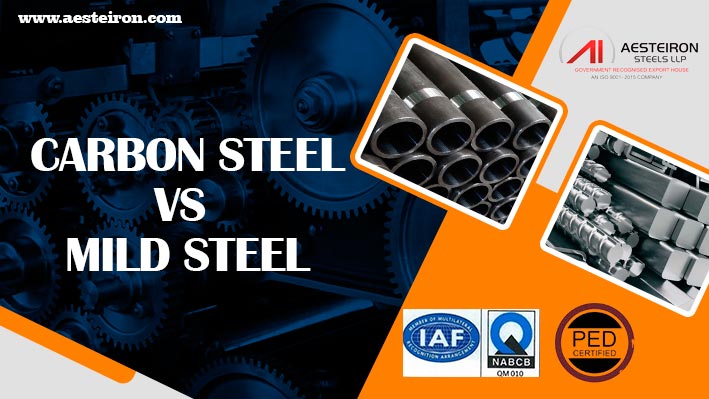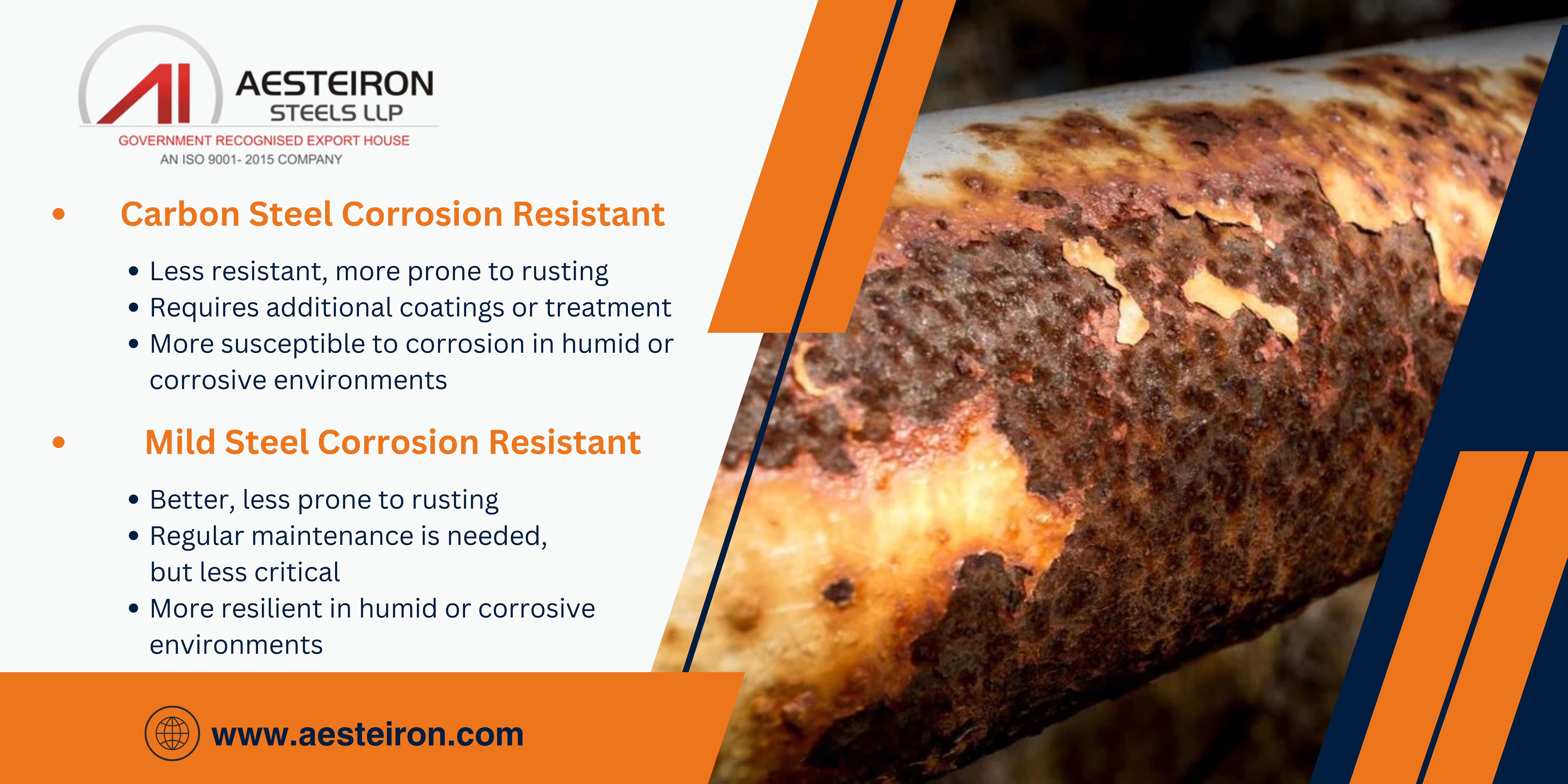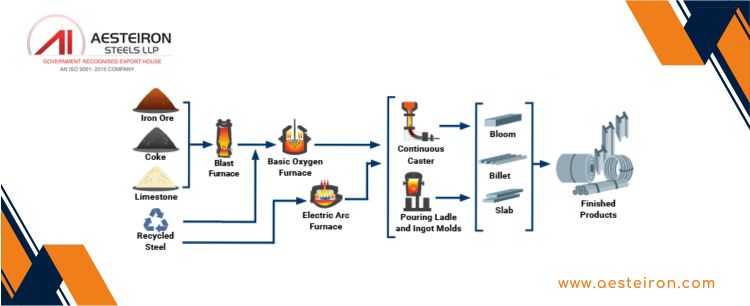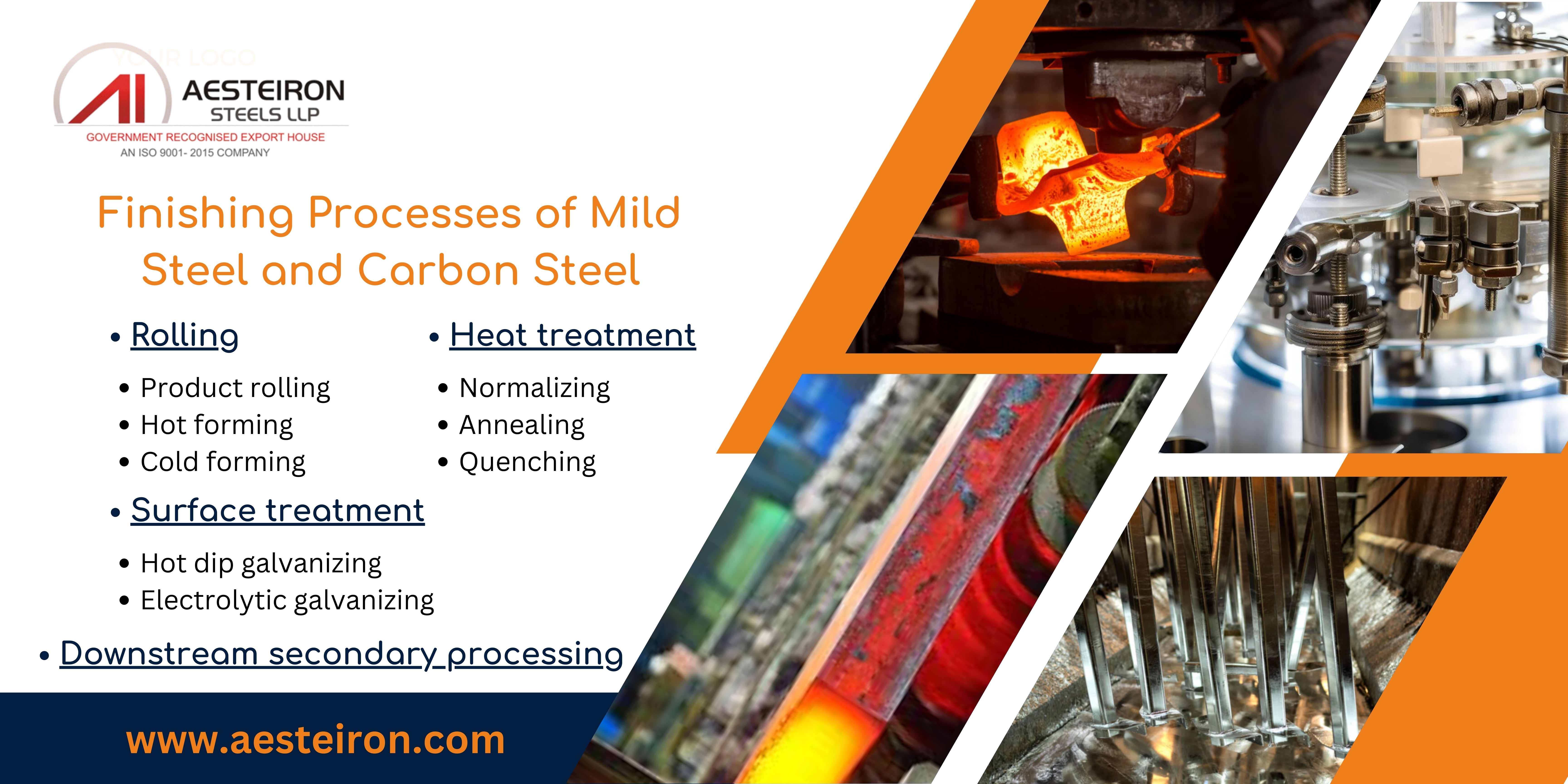
Both materials have unique properties and advantages, making them suitable for different applications. The table below provides a clear comparison between carbon steel and mild steel, helping you choose the right material based on your specific needs.
Table of contents
- Carbon Steel Vs Mild Steel
- What is Mild Steel?
- What is Carbon Steel?
- Types of Carbon Steel
- Composition and Properties of Carbon Steel Vs Mild Steel
- Ductility and Weldability of Carbon Steel and Mild Steel
- Carbon Steel Vs Mild Steel Corrosion
- Weight Difference Between Carbon Steel And Mild Steel
- Carbon Steel vs Mild Steel Properties
- Price Comparison of Carbon Steel vs Mild Steel
- Which is Better: Mild Steel or Carbon Steel?
- Manufacturing Process of Mild Steel and Carbon Steel
- Mild Steel and Carbon Steel Finishing Processes
- Applications of Carbon Steel & Mild Steel
Carbon Steel Vs Mild Steel
| Property |
Mild Steel |
Carbon Steel |
|
 |
 |
| Carbon Content |
0.05% – 0.25% |
Up to 2.1% |
| Strength |
High |
Moderate |
| Ductility |
Low to Moderate |
High |
| Cost |
More expensive |
Cost-effective |
| Finishing |
Smooth finish |
Harder to machine and weld |
What is Mild Steel?
| Point |
Details |
| Definition |
Mild steel is low-carbon steel. |
| Carbon Content |
Contains a low percentage of carbon. |
| Alloying Elements |
Manganese, silicon, and trace phosphorus. |
| Strength and Hardness |
Strong but relatively soft compared to higher-carbon steels. |
| Common Uses |
Wires, steel sheets, and building materials. |
| Popularity |
Accounts for 85% of U.S. steel products. |
| Properties |
Known for strength, ductility, and affordability. |
What is Carbon Steel?
| Point |
Details |
| Definition |
Has carbon as the primary alloying component. |
| Carbon Content |
Ranges from 0.05% to 2.0%, sometimes higher. |
| Versatility |
Widely used due to adaptability and affordability. |
| Applications |
Structural components, machinery parts, tools, and industrial equipment. |
| Corrosion |
Prone to rust; mitigated with coatings or maintenance. |
Carbon Steel is Stronger, Harder, and More Brittle Than Mild Steel
When it comes to structural integrity, strength is essential. It ensures that the material can withstand harsh conditions without bending or breaking. Hardness is also important for resisting deformation or scratching under external pressure. These properties are typically tested using methods like Brinell hardness or Rockwell hardness scales. The following table provides a detailed comparison of the types of carbon steel and their characteristics.
Types of Carbon Steel

| Type of Carbon Steel |
Carbon Content (%) |
Properties |
Common Uses |
| Low |
0.05 to 0.15 |
Ductile, flexible |
Automotive parts, piping |
| Medium |
0.3 to 0.5 |
Balanced ductility and strength |
Tanks, pressure vessels |
| High |
0.6 to 1.0 |
Very hard |
Cutting tools, blades |
| Ultra High |
1.25 to 2.0 |
Very hard, brittle |
High-quality knives |
Composition and Properties of Carbon Steel Vs Mild Steel
| Type of Steel |
Elements |
Carbon Content |
Properties |
| Carbon Steel |
Iron and carbon |
Up to 2.1% |
Stronger but more brittle |
| Mild Steel |
Iron and carbon |
0.05% to 0.25% |
More ductile and malleable |
Mild Steel is Generally More Weldable Due to Lower Carbon Content
Ductility and Weldability of Carbon Steel and Mild Steel
|
Details |
| Carbon Content |
Low |
| Properties |
Soft, easily shaped |
| Uses |
Construction, welding |
Carbon Steel Vs Mild Steel Corrosion

Carbon Steel
| Property |
Details |
| Strength and Durability |
Higher carbon content increases strength and durability. |
| Ease of Workability |
Lower melting point makes it easier to work. |
| Corrosion Susceptibility |
More prone to rust and corrosion. |
| Maintenance |
Requires regular protective coatings to prevent deterioration. |
Mild Steel
| Property |
Details |
| Flexibility |
Greater due to lower carbon content. |
| Strength |
Less than carbon steel. |
| Corrosion Resistance |
Better, but still needs maintenance. |
| Maintenance |
Regular upkeep needed in harsh conditions. |
Weight Difference Between Carbon Steel And Mild Steel
| Steel Type |
Carbon Content |
Range |
| Mild Steel |
Lower carbon content |
0.05% – 0.25% by weight |
| Carbon Steel |
Higher carbon content |
0.05% – 1.70% by weight |
Carbon Steel vs Mild Steel Properties
| Property |
Mild Steel |
Carbon Steel |
| Workability |
Easier to work with |
Tougher to work with |
| Cost |
Cheaper |
More expensive |
| Strength |
Less strong; suitable for basic structures |
Stronger; ideal for heavy machinery and high-pressure applications |
| Welding |
Easier to weld |
More difficult to weld |
Price Comparison of Carbon Steel vs Mild Steel
| Property |
Details |
| Cost |
$800 to $1,000 per ton |
| Strength |
Stronger |
| Flexibility |
Maintains flexibility while being strong |
| Applications |
Large projects like skyscrapers and bridges |
| Value |
Cost-effective for strength |
Carbon Steel is Up to 20% Stronger Than Mild Steel
Below is a breakdown of how carbon content affects the performance of both materials, making them suitable for different uses.
Which is Better: Mild Steel or Carbon Steel?
| Property |
Mild Steel |
Carbon Steel |
| Best For |
Low-stress applications |
High-strength applications |
| Advantages |
- Easier to fabricate
- Lower cost |
- Up to 20% stronger
- High hardness |
| Strength |
Less strong |
Significantly stronger |
| Cost |
Lower cost |
Higher cost |
| Welding |
Easier to weld |
More difficult to weld |
Black Mild Steel is More Pliable and Easier to Form
Mild steel is known for its excellent malleability and ductility. This makes it easy to shape and form, which is essential in construction and manufacturing. Its flexibility reduces labor costs and time, making it an attractive option for many industries.
Manufacturing Process of Mild Steel and Carbon Steel

The production of carbon steel and mild steel involves three main stages:
- Primary processes
- Secondary processes
- Casting processes
Primary Processes
| Point |
Detail |
| Production Methods |
Virgin steel or 100% recycled material |
| Process |
Basic Oxygen Furnace (BOF) |
| Steel Types |
Mild and carbon steel |
| Raw Materials |
Iron ore and coke |
| Oxygen Injection |
Pure oxygen is used to oxidize excess carbon |
| Carbon Content |
Up to 0.5% |
| Casting |
Steel is poured into molds to produce slabs or ingots |
Secondary Processes
| Secondary Steelmaking Processes |
| Purpose: Enhance steel quality and consistency by adjusting carbon content and other characteristics. |
| Electric Arc Furnace (EAF): |
Deoxidizing Steel |
| Importance: In an Electric Arc Furnace, the Temperature Can Be Adjusted, Certain Components Can Be Added or Removed, or Both. |
Importance: Essential for controlling steel properties and suitability for specific applications by eliminating oxygen. |
| – Stirring: Ensures uniform composition by removing not metallic impurities. |
Types of Steel Based on Deoxidation: |
| – Ladle Furnace: Allows accurate control of temperature and addition of alloys components. |
– Rimming Steels: Non-deoxidized or partially deoxidized; may produce carbon monoxide. |
| – Ladle Injection: Injects inert gas to stir the steel bath and achieve a homogenous mixture. |
– Capped Steels: Similar to rimming steels but with a capped mold to prevent carbon monoxide formation. |
| – Degassing: Removes unwanted gases (hydrogen, oxygen, nitrogen) and reduces sulfur content. |
– Semi-Killed Steels: Moderately deoxidized, with carbon content between 0.15% and 0.3%. |
| – Composition Adjustment: Uses sealed argon bubbling and oxygen blowing (CAS-OB) for precise adjustments. |
– Killed Steels: Fully deoxidized to eliminate carbon monoxide during solidification. |
Casting Process
| Traditional Casting Methods |
Continuous Casting Methods |
| Pour molten steel into each mold that is set up on a rail vehicle. |
Produce molten steel into slabs, blooms, or billets. |
| For hot rolling, ingots are transferred to soaking pits to reheat. |
Directly cast steel into shapes more suitable for downstream processing. |
| Uses discrete molds to create individual ingots. |
Uses a continuous casting machine for efficient production. |
Mild Steel and Carbon Steel Finishing Processes

Rolling
| Rolling Process |
Description |
| Product Rolling |
– Rolls solid cast ingots into usable shapes. |
|
– Compared to steel, rolls rotate more quickly, propelling and compressing it. |
| Hot Forming |
– Steel heated above recrystallization temperature. |
|
– Breaks up as-cast microstructure for uniform grain size and even carbon distribution. |
| Cold Forming |
– Done below recrystallization temperature. |
|
– By strain hardening, the strength can be increased by up to 20%. |
|
– Materials that are semi-finished are processed into intermediate products for further use. |
Heat Treatment
| Heat Treatment Process |
Temperature Details |
Cooling Method |
Effects on Steel |
| Normalizing |
Approx. 55°C (130°F) |
Air-cooling |
Increases strength and hardness |
| Annealing |
Heated for one hour; cooled at 21°C (70°F) |
Controlled cooling |
Softens and increases ductility |
| Quenching |
Much like normalizing |
Water, brine, or oil |
Very hard but brittle |
| Tempering |
Typically between 150-650°C (300-1200°F) |
Controlled cooling |
Reduces brittleness |
Surface Treatment
| Process |
Method |
Benefits |
| Hot Dip Galvanizing |
Dipped in molten zinc |
Corrosion resistance; weldable |
| Electrolytic Galvanizing |
Electric current in zinc solution |
Precise coating; corrosion resistance |
Downstream Secondary Processing
- Raw Materials: Steel is processed into finished products by downstream companies.
- Machining: Uniformly removes surface metal using machine tools.
- Joining: Includes welding to combine steel parts.
Mild Steel is Widely Used for Low-Stress Applications While Carbon Steel is Used for High-Strength Applications
The table below shows where each type of steel is commonly applied.
Applications of Carbon Steel & Mild Steel
| Application |
Steel Type |
Key Points |
| Construction |
Mild Steel |
Used for building frames, bridges, and structures. |
| Automotive |
Carbon Steel |
Strong and hard; used for engine parts and chassis. |
| Tools |
Carbon Steel |
Used for tools like knives and drills. |
| Pipes and Pipelines |
Carbon Steel |
Ideal for strength and corrosion resistance in chemical and gas transport. |
| Cookware |
Carbon Steel |
Used for pans and knives; provides even heating. |
| Decorative Elements |
Mild Steel |
Flexible and easy to shape; used for gates, railings, and sculptures. |
| Cost Considerations |
Mild Steel |
More affordable and easier to obtain. |
| Carbon Steel |
More expensive but suitable for long-term use. |
Crawler Chasis
The feature of rubber tracks
(1). Less round damage
Rubber tracks cause less damage to roads than steel tracks and less rutting of soft ground than either steel tracks of wheel products.
(2). Low noise
A benefit to equipment operating in congested areas, rubber track products less noise than steel tracks.
(3). High speed
Rubber track permit machines to travel at a higher speed than steel tracks.
(4). Less vibration
Rubber tracks insulate machine and operator from vibration, extending the machine's lifetime and lowering operate fatigue.
(5). Low ground pressure
The ground pressure of rubber tracks equipped machinery can be fairly low, about 0.14-2.30 kg/ CMM, a major reason for its use on the wet and soft terrain.
(6). Superior traction
The added traction of rubber, track vehicles permits them to pull twice the load of wheel vehicles of the sane weight.
Application and Features:
1. Suitable for the small wheelchair.
2. Can load weight about300-400KG
3. Length can be adjusted.
4. Sprocket is available.
Characteristics of rubber track:
1). Less damage to the ground surface
2). Low noise
3). High running speed
4). Less vibration;
5). Low ground contack specific pressure
6). High tractive force
7). Light weight
8). Easy to change
Crawler Chasis,Crawling Chase,Undercarriage For Drilling Machine,Rubber Track For Drilling Rig
JIANGSU XI TEC ENVIRONMENTAL&DRILLING EQUIPMENT COMPANY CO.LTD , https://www.xitecdrilling.com






